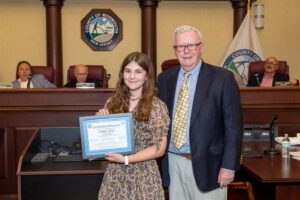Madeline Dougherty, a fifth grade student at St. Leo the Great School in Lincroft, tied with Juliana Saliga, daughter of Mr. and Mrs. Robert Saliga of Middletown, a fifth grade student at St. James School in Red Bank to take the third place awards in the Monmouth County Historical Commission’s annual essay contest for fifth grade students throughout Monmouth County.
The first place award went to James Badishkanian of Oak Hill Academy and second went to Rily Lanigan of the Atlantic Highlands Elementary School.

Ms. Dougherty wrote about the history of the Twin Lights Historical Museum in Highlands.
Twin Lights History
By Madeline Dougherty
Monmouth County is rich in history. All over the county you can visit monuments where people put their blood, sweat and tears to try to fight for what they believed in. One of the most important lighthouses in Monmouth County was the Twin Lights.
The Twin Lights are located near the Sandy Hook area and have had many important roles in history including being the brightest lighthouse in 1841 that lit up the ocean where seafarers used to bring cargo into New York Harbor, the first location where wireless telegraphs were used and the first location where the Pledge of Allegiance was recited.
The Twin Lights are two lighthouse, but are the same building. They are situated atop the Navesink Highlands and are two hundred feet above sea level. The current lighthouse was built in 1862 after the earlier building had fallen apart. The Twin Lights project cost seventy-four thousand dollars and the unique design with two identical towers were separated by quarters and rooms was Joseph Lederle’s work.
The lenses installed were Fresnel lenses a “first order ‘light in the South tower and a ‘second order’ in the North tower.
The lenses made up glass beehives and had a series of prisms that surrounded the main light source. After the installation, the Twin Lights became superior to any navigational lightning source at that time and the best.
In 1898 an electric-arc bivalve lens replaced the South Tower beehive light and was visible twenty-two miles out into the ocean, and sometimes could be seen seventy miles away reflecting in the night sky. The South Tower became so powerful in light that the North Tower was taken out of service only to be re-lit in 1962 after a smaller fifth Order lens was placed there.
The Twin Lights are known for three reasons. First, the first wireless telegraph was sent form the Twin Lights. Guglielmo Marconi was the person who invented a wave that could send signals through air to a receiver many miles away. When Marconi became famous for his technology the Navy’s Bureau of Equipment was unable to enter into an agreement with Guglielmo Marconi and soon set up their own wireless station there. Second, on April 25, 1893, on a drizzly and cold morning, dignitaries from Boston, New York and Washington stood in front of the Twin Lights , looked up at the Liberty Pole and recited for the first time the Pledge of Allegiance. Finally, a jump in technology happened at the Twin Lights. The first radar was tested at the Twin Towers and in 1939 testing radar could pick up a B-17 bomber flying over Long Island, New York
When I stepped into the Twin Lights, I felt like I was going back into time. I learned so much about what role the Twin Lights played in making history for Monmouth County. Without the contributions of the Twin Lights, events could have turned out much different for our nation.
I am just a lucky person to live in such a great county, Monmouth County, full of history.

The Vietnam War Memorial Museum
By Julianna Saliga
The place that I am writing about is the New Jersey Vietnam Memorial Museum. When I walked in, I was surrounded with everything there is to know about the Vietnam War . It made me come to imagine how hard it was to survive there. The men and women who fought in the war were only about 19 years old.
The man who gave my family and I a tour of the museum fought in Vietnam. He was 20 years old and was there for one year. He saw things that are still hard for him to talk about today. What was truly touching was that he thanked us for coming because it helped him heal by telling his story to other people.
One thing in the museum that really fascinated me was the letters that the soldiers and their loved ones wrote to each other. It took about 2-3 weeks each way do reach the other person. In one letter, a woman was telling a soldier that he was going to be a dad. He died before he even received the letter.
He didn’t even know he was going to be a father.
During the Vietnam War, after a person passed away in service, a telegram was sent to the family to tell them the news. Because this seemed unkind, a woman in the military and a uniformed soldier came up with a finer idea that an armed service person should go to the family’s house and gloomily tell the household when their loved one in service had sorrowfully died.
Another story in the Vietnam War was the use of agent orange. It was a type of chemical sprayed primarily over Da Nang airbase in Vietnam to kill vegetation because the tall grasses hid the people the US soldiers were looking for. This later led to major health problems, and 400,000 Vietnamese people have died.
I’m very glad that I visited this historic place. I learned so much there and hope to visit it again.